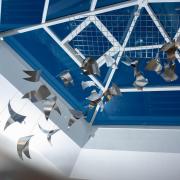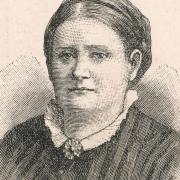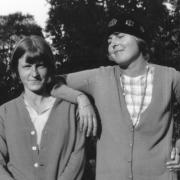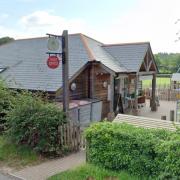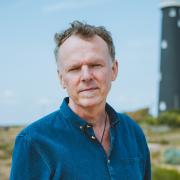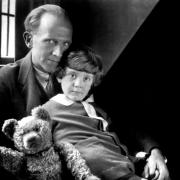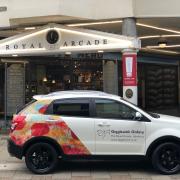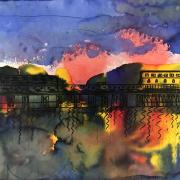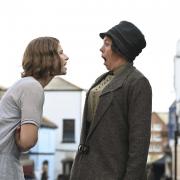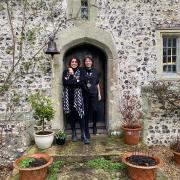How Horsham artist Alison Ingram’s work has been soaring ever since she ditched her traditional methods of painting and instead focused on dramatic depictions of wildlife and soaring swifts.
There are days when Alison Ingram doesn’t have to look far for inspiration. A glance out of the window of her rural Horsham house is often all it takes to provide the subject matter for her next piece of work.
She has been a passionate animal lover since childhood, when her unusual menagerie of pets included snails. Nowadays she cares for injured swifts and other creatures at her home close to Warnham Nature Reserve. The site, populated by deer, foxes, rabbits, badgers and more than 100 species of birds, supplies an ever-changing and a rich source of material for her paintings of British mammals and birdlife.

‘My main inspiration is the wildlife I encounter, a glimpse of a roe deer disappearing into the woods, an acknowledgement of each other’s presence before a fox slinks off into the undergrowth. Observing social behaviour in birds, just trying to understand the wildlife I see, how it behaves and moves,’ explains Alison as she takes a break from working in the small studio at her home. ‘The whole area is rich in wildlife, especially birds, despite the encroachment of the town. The change in the seasons and the change in behaviour of wildlife is interesting, including the bird migrations and change in predominant species.’
Regularly exhibiting her work at Wildlife and Wetlands Trust sites at Arundel, Barnes and Slimbridge, Alison is a regular artist in residence at the Nature in Art museum and gallery near Gloucester, which also owns two of her paintings. Her work has been shown in America at the international Society of Animal Artists’ annual exhibitions and, closer to home, been produced as a range of cards available in galleries, museums and gift shops nationwide, including Horsham Museum.
Alison, 54, is known for her vibrant and colourful award-winning wildlife studies, but that hasn’t always been the case and at the outset her work was much more traditionalist.
Growing up she was always keen on art and from an early age ‘can’t remember considering anything else’ other than being an artist. It was also natural that she combined her two great passions of art and animals, the latter fuelled by growing up in the countryside and spending a time on a friend’s farm.
‘I remember collecting snails to keep as pets, which wasn’t very successful although my mother was pleased to have them removed from the garden,’ she laughs. ‘The farmer’s wife wasn’t too impressed with my and her daughter’s attempts to catch and keep mice and rats as pets though. Being surrounded by wildlife and farm animals created a deep love and respect for animals and birds.’

Alison admits her art education didn’t follow a conventional route. ‘My art training wasn’t very successful, a D in Art A Level although I did get a Diploma in Art Foundation Studies at Northbrook College,’ she says. ‘I didn’t get into art college though. I had been encouraged to study graphics, when I wanted to concentrate on fine art, so when it came to applying to university I wasn’t that interested in the courses I applied for. Instead, I spent a year painting murals around Horsham with a friend. Then I went to Leicester University and got a BA (Hons) Archaeology. I did quite a lot of illustration work through my course and got to travel, which I enjoyed, and I had various part time jobs which gave me time to paint as well.’
Despite her A Level grade, an earlier teacher had spotted the potential in what was to become one of her favourite birds to paint.
‘Puffins are a very popular subject no matter what style of painting or craft,’ Alison says. ‘They’re endearing, comical characters and they’re striking looking birds. They lend themselves to my style, although I’ve always painted puffins. In fact I made a pair of puffins as part of my ceramic O Level, which I still have, despite one my teachers wanting to buy them.’
In the late 1980s the Barns Green annual art exhibition near Horsham provided the springboard for her first paintings to be exhibited and sold. She was also given a break by the Lannards Gallery, Billingshurt, which supported her work. Alongside wildlife paintings, Alison developed a commercial career which included painting cat and dog breeds for a company selling pet products, although she confesses to finding it ‘really boring’.
‘I was also entering paintings into wildlife exhibitions but I didn’t feel I had a recognisable style or any direction,’ she continues. ‘There were much better traditional wildlife artists than me and I didn’t feel I could achieve the level of technique to produce the quality I was aiming for.’
In the meantime Alison was drawn to the work of German expressionist painter Franz Marc, renowned for his images of brightly coloured animals, and created her own version of one of his works. It proved to be a pivotal turning point that marked her entry into the world of semi-abstract art in 1999 - and also involved puffins.
‘This was a bit of fun experimenting in oil paints, in between painting pet portraits,’ she explains. ‘I really enjoyed the change of palette, medium and style. I then decided to attempt to rework a watercolour puffin painting that I wasn’t happy with. I started looking for patterns and overpainted the watercolour with gouache.’

The result was Puffin Paradise which won first prize in the abstract/experimental category of The Artist magazine’s Celebration 2000 competition and was sold the following year at the Wildlife Art Society’s annual exhibition in Bristol. Subsequent accolades include being a four time finalist in the David Shepherd Wildlife Foundation (DSWF) international Wildlife Artist of the Year awards and winning a gold award in the Wildlife Art Society’s annual exhibition.
Alison has visited Skomer Island in Pembrokeshire to study puffins. ‘I still love painting puffins on cliff edges where they nest,’ she says. ‘They arrive in their breeding grounds in spring when the cliff edges are blanketed in flowers. It makes for joyful paintings with their black and white plumage and most beautiful eye markings and beaks.’
She doesn’t have to travel so far afield for her studies of red deer, which roam close to the home she shares with her forester partner Michael, German shepherd dog Quattro and a small flock of chicken and ducks.
‘I have easy access to red deer, she says. ‘At certain times of the year they are in the paddock behind my house. I spend time observing, sketching and photographing them and then work in my studio. I can often see the deer from my window.
‘The painting process is the same for all my paintings, I start with my reference photos and sketches and use cut outs or tracings and come up with a composition, trace an outline and start painting and see what happens. It’s intuitive. I don’t plan the painting other than the initial composition of the birds or wildlife, or landscape if that’s the main feature. I just start painting and see how it develops, in terms of both colour and design. The finished painting is very different to the initial painting underneath, which is loose and more traditional. It’s a long process and it might seem odd that such neat, finished paintings start life with so little planning but this is how I have always worked.’
Alison’s work is available through her website (alisoningram.co.uk) with prints starting from £45 and original paintings from £300. She also undertakes commissions.
‘The most interesting one was for a retired glider pilot from Finland who wanted to feel he was flying high with swifts,’ she says. ‘Another was for swifts over Corfe Castle and the client did not want to see the painting at all until he received it, which is very unusual. This gave me the freedom to work as if the painting was for myself. I usually send regular updates to my clients to check they are happy with the way the painting is developing.

Alison is currently working on a large swift painting for the Global Birdfair taking place in Rutland in July. These distinctive birds are close to her heart and she is co-ordinator of the swift project which is part of Wild about Warnham scheme to increase biodiversity within the parish. She’s also on the Swift Conservation carers list, looking after any migratory adults that are grounded after flying back to the UK from Africa and any swiftlets that fall from their nests.
‘Swifts never land on the ground, they spend their lives on the wing apart from when breeding, she explains. ‘Unlike other birds, a swift on the ground is in trouble and needs to be picked up and brought to a carer.’
Alison was delighted to be asked by Penguin to produce a swift painting for the cover of naturalist Mark Cocker’s latest book One Midsummer’s Day published this month (note to sub June) which marks another high spot in her career.




